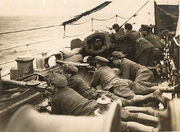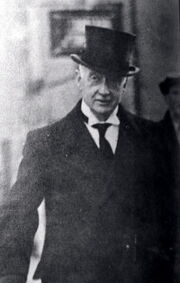Previous: Revolution in Ireland
We now come to the last question: why the numerous militant and revolutionary groups that exist in Ireland today have failed, so far, to bring the revolution in Ireland to victory?

"There can never be peace in Ireland until the foreign, oppressive British presence is removed, leaving all the Irish people as a unit to control their own affairs and determine their own destinies as a sovereign people, free in mind and body, separate and distinct physically, culturally and economically".
To answer that question we need to pose the question of the nature of revolution in Ireland today. Many of the Irish nationalist organizations believe that the root of the evil are the English. If the English army is to depart from the island, then the 6 counties of Northern Ireland will be re-united with the rest of the island, and the whole country will be happy (see poster on the right).
In reality, behind the nationalist oppression of the Irish lies the economic and social oppression which an imperialism imparts on its colonies.

James Lalor
James Fintan Lalor (1807-1849), an Irish revolutionary and a journalist. He pointed out that the slogan “Ireland for the Irish” means that land must be returned to the peasants, and hence the English landlordism must be destroyed. Destruction of the English landlordism meant destruction of the English social system. The land, Lalor advocated, should be transfered into the possession of the people as a whole and tilled by the people as a whole.

James Connolly statue in Dublin today. "The of Ireland is the Cause of Labor. The Cause of Labor is the Cause of Ireland"
James Lalor has influenced several Irish nationalists and revolutionaries, and among them the most prominent Marxist of Ireland James Connolly (1868-1916) , one of the leaders of the 1916 rising. James Connoly has founded the first Marxist party in Ireland in 1896, the Irish Socialist Republican Party. Its goal was an "Establishment of AN IRISH SOCIALIST REPUBLIC based upon the public ownership by the Irish people of the land, and instruments of production, distribution and exchange." Specificaly, points of its program called for:
"Nationalisation of railways and canals.
Abolition of private banks and money-lending institutions and establishments of state banks, under popularly elected boards of directors, issuing loans at cost.
Establishment at public expense of rural depots for the most improved agricultural machinery, to be lent out to the agricultural population at a rent covering cost and management alone", etc.
And so we see that it is already socialist revolution which is on the order of the day in Ireland. All other "revolutions" meant in reality a compromise with the English social system. This is exactly what happened during the Anglo-Irish war of 1919-1921, which was fought initially over the issue of independence for Ireland. The treaty concluding the war split the island into 2 parts, the North, more industrially developed and dominated by the pro-English majority, and the rest of the island, mostly agricultural and dominated by the Nationalist and Catholic people. According to the book "History of Ireland" (Russ.), the treaty of 1921 was a result of compromise between the weakened English bourgeoisie and the Irish nationalist bourgeois leaders, who were in a hurry to suppress the anti-imperialist war, as it was in a danger of becoming a revolution against the foundations of a capitalist system.

The Freestaters armed with English machine guns.

Liam Mellows, an Irish revolutionary.
The more radical part of the Irish militants did not agree with the terms of the Treaty and continued to fight the "Free State of Ireland" (see the Irish civil war ). These became called the Republicans and their fighting force the Irish Republican Army (IRA). The Free State was backed by the large peasant holders, and the whole of the English army, while the Republicans were backed by the small peasant holders. The former won the day. However, to illustrate the nature of the fighting - what it was for - let's hear Liam Mellows, an IRA commandant-general. Before being shot by the "Freestaters" in prison, he wrote that Free State means capitalism, industrialism, and the British Empire. The Republic means the workers and labor.

W.T. Cosgrave - a typical representative of large bourgeoisie.
The winners in the Irish civil war was the party of the large and middle bourgeoisie, Cummann na nGaedheal , presided by W.T. Cosgrave.
Having entered the League of Nations in 1923, the Irish Free State, in the sphere of foreign policy, followed meekly in line with the British imperialism. Specifically, Ireland refused all contacts with Soviet Russia.
Meanwhile, the official leadership of IRA, which preserved its existence after defeat in the Irish civil war, distanced itself from socialist struggle, limiting itself to demands for national unification. For example, in 1933 all members of the IRA were refused the right to express themselves on social and economic issues.
During World War Two Ireland adopted a position of neutrality, refusing to fight in support of its domestic enemy, the British Empire. Some members of the IRA even demanded to declare a war on Britain.
After World War II, there was some economic development, Ireland was transformed from an agricultural to agricultural-industrial economy, but at a very slow pace.
In comparison with pre-World War II period, industrial employment increased by 1.5 times and, in 1958, 142 thousand people were employed in industry. Meanwhile, the numbers of people employed in agriculture declined by 2 times in comparison with the pre-World War Two period. In 1958 around 350 thousand worked in agricultre (note: still much more than in industry).
In 1973, industry produced twice as much value in the Gross National Product of Ireland as the agriculture. In 1974, 45% of the Irish population was involved in the "tertiary" sector of the economy, i.e. "the services". Today, 78% of the Irish labor force is employed in "services", 19% in industry, and 5% in agriculture (see "Economy of the Republic of Ireland ").
Sinn Fein was re-organized in 1956 to play an increasing role in Ireland's politics (originally, the party gained in numbers when the English mistakenly attribued the Easter 1916 rising to Sinn Fein of Arthur Griffith). The re-organized party demanded an end of government repression against the soldiers of IRA who struggle for the unity of Ireland, an end of all economic ties with England, an end of foreign monopolies in Ireland. However, the party did not put forward an anti-imperialist program.
In 1970, Sinn Fein split into the "official Sinn Fein" and "provisional Sinn Fein". The former became a "Marxist-Leninist" party, bearing the name of "The Workers' Party of Ireland since 1982. It is closely associated with the official IRA and used to support the Soviet Union. Today, the Workers' Party supports the group "Borot'ba" in Ukraine, which is a split from the official Communist Party of Ukraine, but still represents the bureaucracy and Stalinists (read interview here ).
Meanwhile, the "provisional IRA " is characterized by narrow nationalism, Catholicism and anti-communism. It is associated with the Sinn Fein of Gerry Adams (formerly "provisional Sinn Fein"), and has given up on armed struggle, just like the "official IRA".

Bloody Sunday, 1972, mural
Late 1960's - early 1970's was characterized by a crisis in Northern Ireland. The militant "Orangemen", loyal to England, were beating up and murdering on the Catholic population in Northern Ireland. In 1972, the British army paratroopers have murdered a number of civilians at a peaceful demonstration. This is known as "the Bloody Sunday", made popular by a song of U2 ; there is also a 2002 film on the event . This has led to a new spiral of violence, as IRA has conducted an armed campaign in response.
The Irish revolution has remained unfinished to this day.
Ireland is still one of the most depressed regions of Europe, one of the most economically backward. Witness a video "The Story of Ireland ", where we see "ghost towns" in Ireland in 2008 (watch from 49 min.)
The country is still divided into 2 parts, and hence this is "a frozen conflict", like the one in Ukraine today.
Northern Ireland remains a land of discrimination of the Catholic population in all aspects of social life, such as employment, housing, education, medical services, etc. The national liberation in Ireland cannot be completed without a socialist revolution. But, a socialist revolution in Ireland cannot succeed without a global anti-imperialist revolution.
None of the Irish "socialist" parties aims at a global social revolution. They all discuss local politics and like swine do not lift their heads above the national trough. Witness the sites of Sinn Fein (formerly "the provisional Sinn Feinn), the Workers' Party (formerly "the official Sinn Fein"), etc. They all set themselves a limited goal of withdrawal of the British army from the Northern Ireland, and hence this goal is unrealistic. Realism demands demanding "the impossible".
The Irish Republican Socialist Party , founded by 1974, with a leader of Seamus Costello, writes that "there can be no socialism without national liberation in Ireland, nor can there be national liberation without socialism". But they forget to add that there can be no socialism without overthrowing the social and political system in England, and hence in all major imperialist countries.
Ireland is one of those "cracks" in European/global history through which the global revolution may enter the stage in the future.